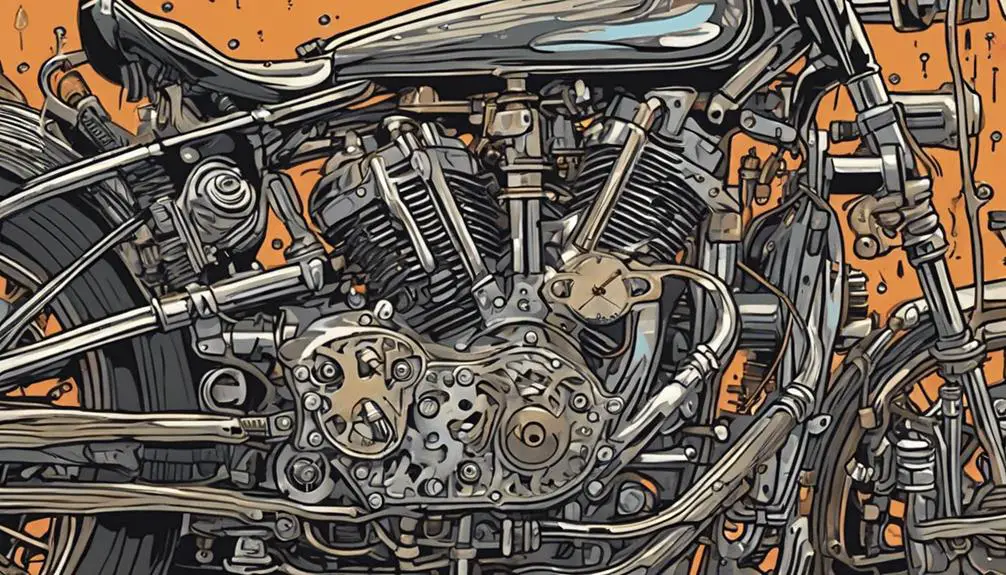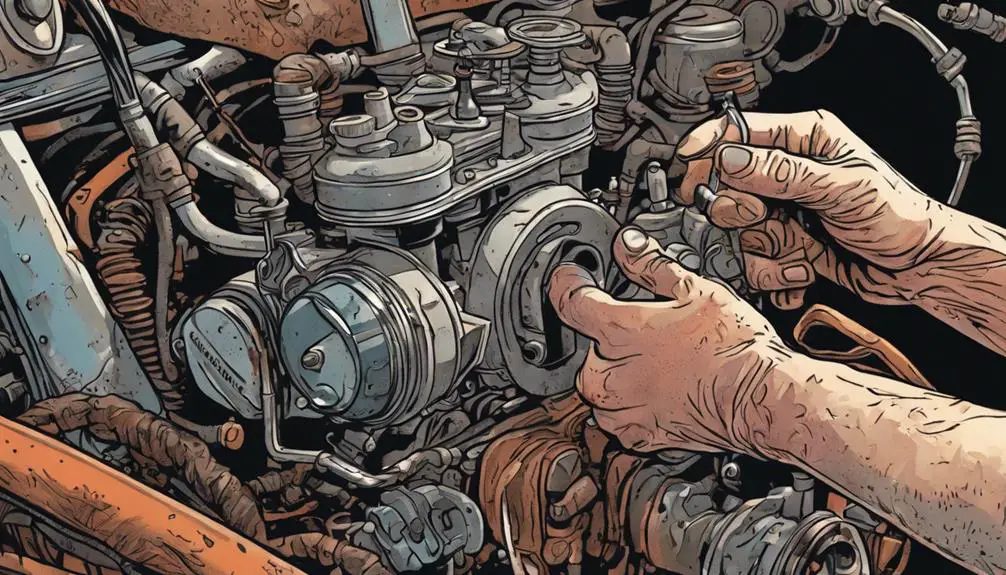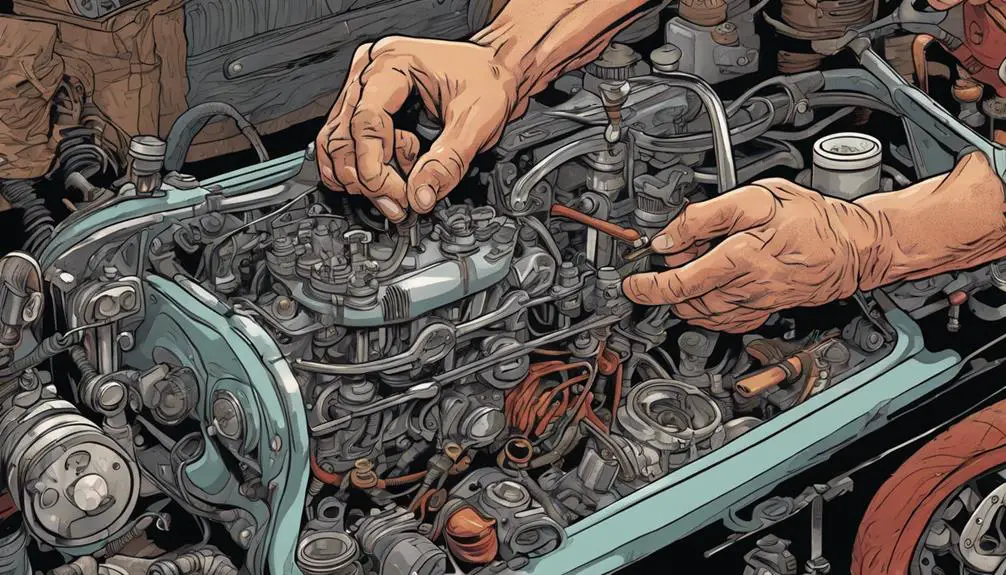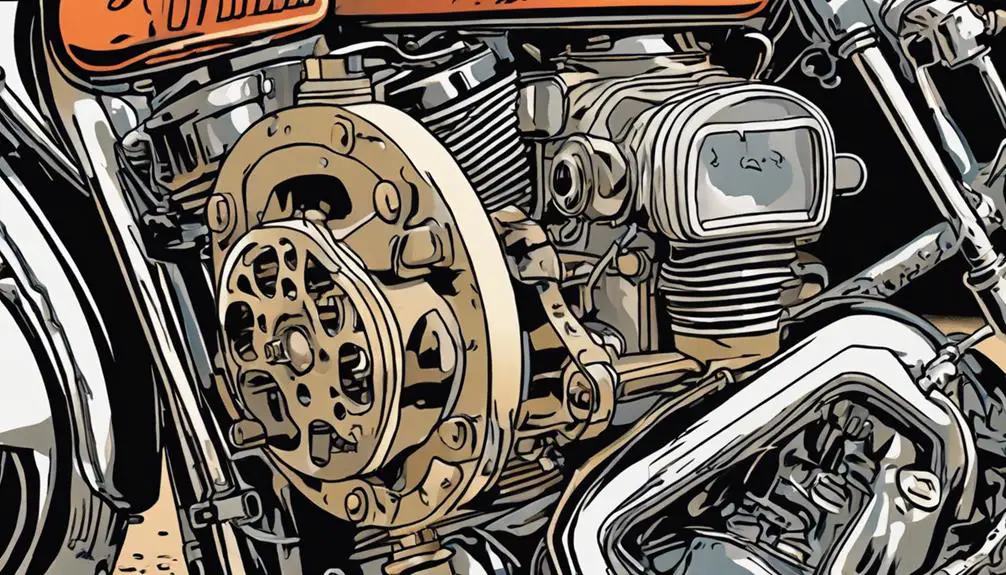Is it true that a well-maintained carburetor can be the difference between a smooth ride and a frustrating breakdown for Bandits? You might underestimate how crucial this component is to your bike's overall performance and safety. When issues arise, they can lead to stalling or poor acceleration, which could ruin your riding experience. Understanding the importance of addressing these problems not only enhances your bike's responsiveness but also guarantees you're maximizing your time on the road. What might you be missing if you overlook these crucial repairs?
Quick Takeaways
- A well-functioning carburetor ensures optimal air-fuel mixing, enhancing engine performance and responsiveness for a thrilling ride.
- Fixing carburetor issues prevents safety hazards like fuel leaks, ensuring a safer riding experience for bandits.
- Regular maintenance and repairs improve fuel efficiency, saving money and reducing environmental impact during rides.
- Addressing carburetor problems promptly prevents more severe engine issues, avoiding costly repairs and downtime.
Understanding Carburetor Function

A carburetor mixes air and fuel in the right proportions, ensuring your engine runs smoothly and efficiently. You mightn't think about it much, but this little device is essential for releasing your ride's true potential. When you press the gas, the carburetor springs into action, delivering just the right amount of fuel to match the air intake. This balance fuels your freedom, allowing your engine to generate the power you crave.
Understanding how a carburetor functions is key to mastering your machine. It's not just about speed; it's about control and responsiveness. The mix of air and fuel creates combustion, igniting the power that propels you forward. A well-tuned carburetor can make all the difference in how your bike or car feels on the road, giving you that exhilarating sense of liberation.
When you grasp the fundamentals of how this device works, you empower yourself to make informed decisions about maintenance and upgrades. Explore the mechanics, and you'll discover that revealing your engine's full potential isn't just about the thrill of the ride; it's about the journey toward mastery and independence. Embrace that knowledge, and let your spirit roam free.
Common Carburetor Issues
Common carburetor issues can greatly affect your engine's performance, leading to frustrating rides and costly repairs. You might notice your bike struggling to start, sputtering during acceleration, or stalling unexpectedly. These problems often stem from a clogged fuel line, dirty jets, or improper float levels.
When the fuel isn't reaching the engine as it should, you can experience a noticeable drop in power and efficiency. A sticky throttle can also throw a wrench in your plans, making it hard to control your speed. You want freedom on the open road, not to be tied down by mechanical headaches.
Another common issue is fuel leaks, which not only waste precious resources but also pose safety risks. If your carburetor is out of tune, you might notice poor fuel economy, costing you more at the pump and keeping you from that liberating ride.
To reclaim your freedom, keep an eye out for these issues. Regular maintenance and timely repairs can help guarantee that your ride remains smooth and exhilarating. Don't let carburetor problems hold you back; take charge of your journey and keep the spirit of adventure alive!
Signs of Carburetor Problems

Noticing the signs of carburetor problems early can save you from costly repairs and frustrating breakdowns on the road.
When your engine sputters or hesitates during acceleration, it's a clear warning sign that something's off. If you smell gasoline more than usual, that could indicate a rich fuel mixture or a leak, both of which can lead to bigger issues.
Another red flag is if your vehicle's fuel efficiency drops unexpectedly—this could mean the carburetor isn't mixing air and fuel properly. You might also hear unusual noises, like backfiring or popping sounds, which signal a misfire in the combustion process.
If your engine stalls frequently, especially when idling, it's likely time to inspect the carburetor. Finally, a rough or uneven idle can indicate that the carburetor isn't functioning smoothly.
Tools Needed for Repair
When tackling carburetor repairs, you'll need some essential tools to get the job done right.
Don't forget to have safety equipment on hand to protect yourself during the process.
With the right gear, you'll be well-prepared to fix those pesky issues.
Essential Repair Tools
You'll need a variety of essential tools to effectively tackle carburetor repairs on your bandit. Start with a set of screwdrivers, both flathead and Phillips, to remove and adjust screws with precision. A wrench set is vital for loosening and tightening nuts and bolts, especially in tight spaces.
Don't forget a torque wrench to verify you're applying the right amount of force—over-tightening can lead to further issues.
Next, grab some pliers and wire cutters. These will help you manage hoses and electrical connections without damage. A carburetor cleaning kit is also a must, as a clean carburetor is key to peak performance. Use a soft brush and solvent to clear out any debris or gunk.
For detailed work, consider a magnifying glass or a good flashlight. You'll want to see every tiny detail clearly.
Safety Equipment Necessities
Ensuring your safety during carburetor repairs requires vital equipment like gloves, goggles, and a sturdy apron to protect yourself from debris and harmful substances. You want to engage in those repairs with confidence, knowing you've got the right gear on your side.
Gloves keep your hands safe from grease and chemicals, while goggles shield your eyes from sharp particles and splashes.
Don't skimp on the apron! It acts as a barrier against spills and stains, letting you focus on the task without worrying about ruining your clothes.
A well-ventilated workspace is also essential; make sure you're in an area where fumes can disperse freely.
Consider a face mask if you're dealing with intense odors or dust. It's all about maintaining your freedom to work without unnecessary hazards.
Step-by-Step Repair Process

To tackle carburetor issues effectively, start by gathering the necessary tools and materials for a smooth repair process. You'll need a socket set, screwdrivers, a carburetor cleaner, gaskets, and a clean workspace.
Once you've got everything, disconnect the carburetor from the engine. Next, check for any visible damage. If you spot cracks or wear, you may need to replace it. If the carburetor looks intact, remove the float bowl to inspect the fuel jets and float. Clean any debris with the carb cleaner, ensuring the jets are clear for ideal fuel flow.
After cleaning, reassemble the carburetor, replacing any gaskets if necessary. Securely attach it back to the engine, making sure all connections are tight.
Maintenance Tips for Longevity
Regularly inspecting and cleaning your carburetor can greatly extend its lifespan and maintain peak performance. Start by checking for any signs of dirt or debris that can clog the jets. Use a soft brush or compressed air to clear away any buildup.
Don't forget to inspect the gaskets and seals, as these can wear out over time. If you notice any cracks or fraying, replace them immediately to prevent leaks.
Next, adjust the fuel mixture according to your bike's specifications. An improper air-fuel ratio can lead to inefficiency and wear. Verify your float level is set correctly, as this impacts fuel delivery. After cleaning, consider using a fuel stabilizer to keep your system fresh, especially if you're not riding regularly.
Lastly, keep an eye on your throttle response. A sticky throttle can signal a deeper issue, so address it promptly.
Performance Impact of Issues

Experiencing carburetor problems can dramatically affect your bike's performance, leading to sluggish acceleration and poor fuel efficiency. When your carburetor's not functioning right, it disrupts the air-fuel mixture, making it harder for your engine to breathe. You'll notice that your bike struggles to pick up speed when you twist the throttle, and those long rides you crave might feel like a chore instead of a thrill.
Fuel efficiency takes a hit, too. If your bike's gulping down more gas than usual, you're not just losing money at the pump; you're also losing the freedom that comes with a well-running machine. Inefficient combustion can lead to a rough idle, making your ride less enjoyable and more of a hassle.
In the world where liberation on two wheels is the ultimate goal, carburetor issues can chain you down. You want your bike to respond instantly and ride smoothly, not be bogged down by performance issues.
Fix those carburetor problems, and you'll reclaim the exhilarating ride you deserve, releasing the full potential of your Bandit and letting your spirit soar free on the open road.
When to Seek Professional Help
If you notice severe issues with your carburetor, like unusual noises or significant drops in performance, it's time to reflect on professional help.
Complex repairs often require specialized knowledge and tools that you mightn't have.
Don't hesitate to reach out to an expert when the problem seems beyond your skills.
Signs of Severe Issues
Recognizing the signs of severe carburetor issues can save you from costly repairs and guarantee your bike runs smoothly. If you notice your engine sputtering or stalling unexpectedly, it's a clear indication that something's amiss. Pay attention to weird sounds, like backfiring or knocking, which can signal deeper problems lurking within.
Another red flag is a sudden drop in fuel efficiency. If you find yourself stopping at the gas station more often, your carburetor might be to blame. Additionally, if you see excessive smoke from the exhaust, this can point to an imbalance in the air-fuel mixture, meaning it's time to take action.
Don't ignore warning lights or a rough idle; these are your bike's way of crying for help. If your throttle response feels sluggish or unresponsive, it's time to consult a professional.
Trust your instincts—when it comes to your freedom on two wheels, waiting too long can lead to bigger problems. The moment you spot any of these signs, don't hesitate. Seek the expertise you need to keep your ride liberating and smooth.
Complex Repair Requirements
When carburetor problems become too complex to handle on your own, it's crucial to seek professional help to avoid further damage and guarantee your bike runs at its best. You might be tempted to plunge in and tackle every issue, but some repairs require advanced knowledge and tools. If you find yourself facing persistent stalling, irregular idling, or excessive fuel consumption, it's time to call in a pro.
Professional mechanics bring the experience you need, especially when diagnosing intricate issues like clogged jets or worn-out gaskets. They can pinpoint problems that may not be immediately visible and implement solutions that assure your bike's performance is liberated from the constraints of malfunctioning parts.
Don't let pride or stubbornness hold you back. Seeking help isn't a sign of weakness; it's a smart move that can save you time, money, and frustration.
Plus, the freedom of the open road feels even better when you know your bike is in top shape. So, when carburetor repairs get complicated, trust the experts to bring your ride back to life. Your adventures await!
Common Questions
Can a Faulty Carburetor Affect My Vehicle's Fuel Efficiency?
Yes, a faulty carburetor can greatly affect your vehicle's fuel efficiency. When it malfunctions, it can either deliver too much or too little fuel to the engine. This imbalance leads to wasted fuel and decreased performance.
You might notice poor acceleration, rough idling, or decreased mileage. By addressing carburetor issues, you can reclaim your vehicle's best performance, ensuring you get the most out of every drop of fuel.
Don't let inefficiency hold you back!
What Are the Safety Risks of Ignoring Carburetor Problems?
Ignoring carburetor problems is like sailing a ship with a hole—you're heading for disaster.
You might experience reduced acceleration, stalling, or erratic engine behavior, which can lead to accidents. A faulty carburetor can also cause fuel leaks, increasing fire risks.
Your freedom to drive safely is compromised. Don't let neglect chain you down; addressing these issues guarantees your ride remains smooth and your journey stays thrilling without unnecessary dangers lurking around the corner.
How Can I Tell if My Carburetor Needs Cleaning or Replacement?
To tell if your carburetor needs cleaning or replacement, watch for specific signs.
If your engine hesitates, stalls, or runs roughly, it's time to investigate.
Fuel leaks or a strong fuel smell can indicate issues too.
Check for excessive carbon buildup or corrosion.
If you're experiencing poor fuel efficiency, that's another red flag.
Don't ignore these symptoms; addressing them can keep your ride smooth and free!
Are There Specific Carburetor Issues Common in Vintage Vehicles?
Ever wondered what carburetor issues vintage vehicles often face?
You'll find that problems like clogged jets, sticking floats, and deteriorating gaskets are pretty common.
These issues can cause rough idling or poor fuel efficiency.
If you're aiming for a smooth ride, keeping an eye on these symptoms helps.
Regular cleaning and maintenance can save you from bigger headaches down the road, allowing you to enjoy the freedom of your vintage beauty.
What Should I Do if I Can't Identify the Carburetor Problem?
If you can't identify the carburetor problem, start by checking for obvious issues like vacuum leaks or fuel supply problems.
Clean the carburetor thoroughly to eliminate dirt and debris.
If that doesn't help, consult a manual or look for online resources specific to your vehicle.
Don't hesitate to seek advice from a mechanic or a knowledgeable friend; sometimes, a fresh set of eyes can spot what you've missed.
Keep pushing forward!
Wrapping Up
In the grand symphony of your Bandit's performance, the carburetor plays an essential solo. Ignoring its needs can lead to a cacophony of stalling and sputtering, drowning your riding experience in frustration.
By fixing those carburetor issues, you're not just tuning the engine; you're releasing a powerful melody of acceleration and efficiency.
So, roll up your sleeves, give it the care it deserves, and let your motorcycle dance down the open road, harmonizing with every twist and turn.